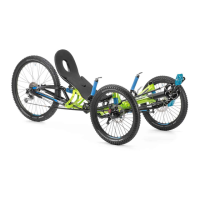
Do you have a question about the HP Velotechnik Scorpion fs 26 and is the answer not in the manual?
| Brand | HP Velotechnik |
|---|---|
| Model | Scorpion fs 26 |
| Category | Bicycle |
| Language | English |
Explanation of how to open, close, and check quick release levers for safety.
Importance of the break-in period (first 300 km) and first service.
Defines the proper usage of the HP Velotechnik tricycle.
Details the maximum load limits for different HP Velotechnik tricycle models.
Guidelines for safely attaching and loading luggage onto the tricycle racks.
Instructions for checking and tightening all screws after initial assembly.
Advice on checking screws for tightness and signs of corrosion.
Information on national legislation and guidelines for riding tricycles on public roads.
Warning against modifying parts that could affect structural integrity or safety.
Details on the location of frame numbers and identification marks on various models.
Cautionary advice on mounting additional parts and accessories.
Information on using front fairings like the Streamer and their effect on handling.
Guidance on replacing safety-relevant parts with original components.
States that tricycles are not designed for child transport; trailers are required.
Guidelines for attaching trailers to specific Scorpion models, including load limits.
Details on the S-Pedelec as a motor vehicle class L2e and its registration requirements.
Information on parts that can be exchanged and those requiring design approval.
Specifies the location of identification plates and frame numbers on the S-Pedelec.
States that transporting children is not allowed on the S-Pedelec.
Explicitly prohibits towing trailers with the S-Pedelec.
Guidance on adapting to the recumbent riding position and handling.
Advice on riding speed, cornering, visibility, and avoiding obstacles.
Recommendations for wearing helmets, protective clothing, and gloves.
Explanation of clipless pedals, their benefits, and the need for practice.
Guidance on adjusting tricycle components for optimal rider fit and comfort.
Detailed steps for adjusting seat length, angle, and lumbar support on various seats.
Instructions for adjusting front boom length for optimal leg extension and pedaling.
Guidance on setting handlebar position for comfort, control, and safety.
Procedures for folding and unfolding various HP Velotechnik tricycle models.
Information on handling, maintenance, and types of brakes used on the tricycle.
Details on bicycle lighting systems, dynamos, and specific S-Pedelec lighting.
Instructions for operating, adjusting, and maintaining the gear system and chain.
Procedures for disassembling, reassembling, and maintaining wheels and tires.
How to adjust the headset for proper steering play and smooth operation.
Instructions for checking and adjusting wheel toe-in, camber, and caster angles.
Guidance on adjusting front and rear suspension for optimal ride comfort and performance.
Details on adjusting the rear suspension element and spring replacement.
Instructions for adjusting and maintaining front suspension struts and customization options.
Maintenance and checking procedures for the swingarm pivot on Scorpion models.
Instructions for mounting, adjusting, and checking mudguards for damage.
Information on mounting water bottle cages on different seat types.
How to clean and protect the tricycle's frame and surfaces from corrosion.
Explanation of normal wear and tear on bicycle parts.
Details on the warranty coverage, exclusions, and claims process.
Information on how the warranty pass ensures safety and proper function over time.
Tips for avoiding seasonal waiting periods for annual inspections.
Checklist for the initial delivery service of a new tricycle.
Details for the first service interval (300 km or 2 months).
Details for the second service interval (3000 km or 1 year).
Details for the third service interval (6000 km or 2 years).
Details for the fourth service interval (9000 km or 3 years).
Details for the fifth service interval (12000 km or 4 years).
Details for the sixth service interval (15000 km or 5 years).
Details for the seventh service interval (18000 km or 6 years).
Details for the eighth service interval (21000 km or 7 years).
Details for the ninth service interval (24000 km or 8 years).
Details for the tenth service interval (27000 km or 9 years).
Details for the eleventh service interval (30000 km or 10 years).
Details for the twelfth service interval (33000 km or 11 years).
Details for the thirteenth service interval (36000 km or 12 years).
Details for the fourteenth service interval (39000 km or 13 years).
Details for the fifteenth service interval (42000 km or 14 years).
Overview of required maintenance and service works based on usage intervals.